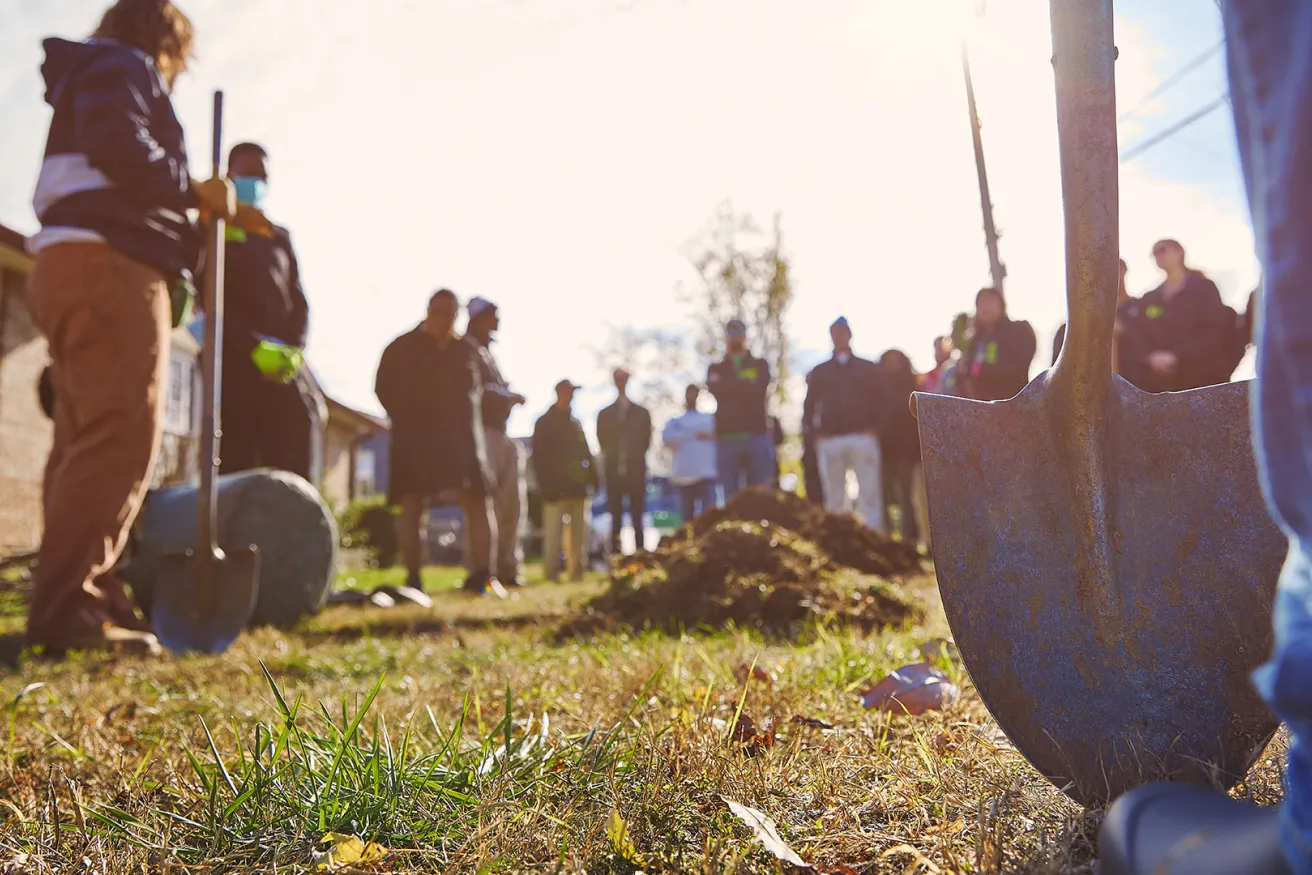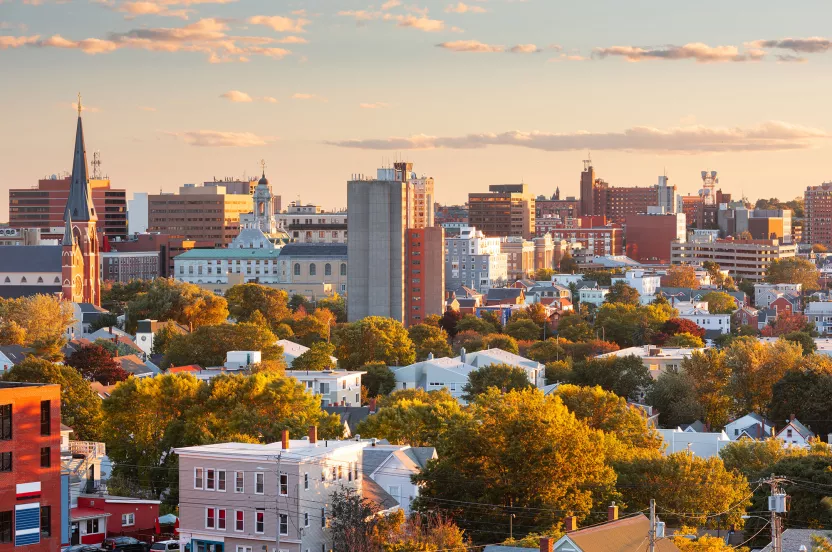The Arbor Day Foundation is pledging 10 million trees to areas impacted by hurricanes Helene, Milton Help us replant
Five Ways to Equitably Engage Residents in Urban and Community Forestry
Dr. Christine Carmichael shares how environmental justice in urban forestry ensures fair tree distribution and resident involvement, with a focus on addressing past inequalities in underserved communities.
September 11, 2024

What is “environmental justice” in urban and community forestry?
Environmental justice has to do with both the fair distribution of resources in a community — like healthy trees — as well as meaningful involvement of residents in decision-making processes about trees, including which species to plant, where, and for what purposes.
To accomplish environmental justice in historically disinvested neighborhoods requires equity, rather than just equality. Equality refers to equally distributed tools and assistance across all neighborhoods. That is the status quo, which is often not enough to improve tree canopy in formerly redlined communities. Equity means providing the custom tools and resources based on each neighborhood’s unique needs. That could mean more financial assistance for both tree planting and tree care, technical guidance on trees to choose from and where to prioritize planting, equipment, and physical labor to help plant and care for trees.
By investing in equity, we have a chance to achieve justice, which means fixing the system in low canopy communities so that we have fairly distributed numbers of healthy trees across a city and communities feel valued and included in the process.
Five ways to engage residents equitably in urban and community forestry
1. Recognize and correct past mistakes.
Based on the historical data, it is clear that past mistakes have been made. Many people have been treated unfairly based on race and ethnicity, as we saw with redlining and its impacts on trees. So the first way to equitably engage residents in urban and community forestry is to recognize and correct past mistakes.
Some examples of how to recognize and correct past mistakes are in Seattle’s 2020 Urban Forest Management Plan, in which they:
- Explicitly define “Environmental Justice Priority Communities” using tools like the Climate and Economic Justice Screening Tool.
- Noted their commitment to ongoing, intentional engagement with these priority communities.
- Outlined a specific outcome of the plan focused on Racial and Social Equity, which means tracking that: urban forest benefits and responsibilities are shared fairly across communities, community trust is built, and decisions are guided by diverse perspectives.
You can also recognize and correct past mistakes by applying the REACH approach to restorative justice. This means you show:
- Respect: Express respect to the community residents you serve from disinvested communities.
- Empathy: Reflect an understanding of their feelings.
- Accountability: Take responsibility for your part and/or the part of your organization in their painful experience. Acknowledge where past behaviors were problematic.
- Centering people: Emphasize the importance of their perspective in creating healthy urban forests.
- Healing: Ask what you can do to repair harm.
2. Ask questions to gauge trust with the communities you serve.
Communities that have experienced generations of environmental injustices often express distrust of government agencies and/or nonprofit organizations that plant trees throughout the city. This is problematic because, as Portland Parks & Recreation (2018) noted in their equitable tree planting strategy document, “Without trust or relationships with city bureaus or nonprofits planting trees, participants said they were not likely to participate.” So it is vital to gather information from people about their existing level of trust in government agencies and nonprofit organizations, and then take steps to build more trust for the future.
Research shows that trust can be broken down into three components:
- Ability: How smart or competent you are. This is shown by displaying skills and knowledge, about trees, and recognizing and correcting past mistakes.
- Integrity: How aligned your words and actions are. This means that you are keeping your promises.
- Benevolence: How much you have other people’s interests at heart. This is shown through warmth and active listening, and vulnerability and taking care of people (not taking advantage of them). For example, you could provide translation services, childcare, transportation or other resources to participants at your events.
To gauge trust, you can ask the following question on a survey of residents:
Based on your experience with our organization and employees, place a check mark next to the statements below that you believe are accurate:
This organization and its employees...
- Have skills and knowledge that are needed to improve urban trees in my community
- Share information openly, and deliver on their promises
- Care about serving the best interests of me and my neighbors.”
Just with this one question, you can gauge the three dimensions of trust. Other questions to gauge trust can be found here.
You can use this feedback to identify areas where you are doing well and areas for improvement. This is one way to increase meaningful involvement of residents in your programs, which is a part of equity and achieving environmental justice.
3. Ask questions to build trust with the communities you serve.
The next step is to ask questions that will help you build trust with historically disinvested communities. This requires practices that engage diverse people in different stages of the urban forest management process (University of Minnesota Extension).
For example, in developing the revision to Ann Arbor, Michigan’s Urban Forest Management Plan, the project team created “Ward Walks” (or walks through each neighborhood of the city) with survey questions (online and in print) to involve residents in decision-making steps.
4. Provide physical and material support for tree planting and care.
A key component of equity is providing custom tools and resources that a community needs to accept trees and help them thrive. This can include equipment like stakes, rope, and mulch — which are resources that the City of Bridgeport, Nebraska, provides through its program. This also involves providing physical support, like having youth organizations (such as 4H and the Girl Scouts) plant trees for older residents or those with disabilities and other physical limitations. Some cities also help pay for and conduct tree watering and pruning for residents.
You can also facilitate workshops in multiple languages. Openlands in Chicago has provided free workshops and their TreeKeepers program in both English and Spanish to be more accessible to the area’s Spanish-speaking community. If you do this, try to provide childcare or children’s activities so that families are more likely to attend.
To amplify the impact of your efforts, partner with local businesses and community-based organizations that can spread the word about your programs and events — and perhaps can even provide resources like childcare or children’s activities as well as gift cards. You can even contact your state urban and community forestry coordinator to inquire about financial resources that you could apply for through the state to fund your events.
Be sure to ask event participants questions to evaluate how successful the event is, such as:
- Did you enjoy the engagement activities today?
- Are you more confident in helping to take care of trees as a result of this workshop?
5. Recruit and retain more diverse Board or Department members
Start with your dedicated and active volunteers who live in the communities served. Ask them if they would be interested in serving on the Board, sharing what type of commitment and compensation is involved. There are several ways to provide compensation: Food, a stipend, professional development opportunities, and the opportunity to meet their neighbors and develop a social network.
Ask your staff members and volunteers who interact with community residents often to suggest someone who may be interested in serving. This could be a particularly vocal or engaged resident. Also, use multiple platforms to advertise open seats, including social media pages, websites, and newsletters read by local residents. Consider setting up a table at a local coffee shop, library, or grocery store to advertise openings and talk with prospective candidates.
Lastly, ask all candidates what concerns they may have about serving on a Board and what might motivate them to do so. Then, discuss ways to address concerns and maximize positive outcomes for them if they join the Board.
Watch the Webinar
Get Dr. Carmichael’s complete breakdown of these five steps in her recent webinar. Please use passcode: 7V3!apSr
Need more help?
Fair Forests Consulting, LLC provides many services to help you design and implement the equitable engagement and environmental justice strategies you read about here. Feel free to email Dr. Carmichael to set up a time to discuss how Fair Forests can help you: [email protected].
Some key services include: reviewing related plans and documents; conducting a community relationship inventory; designing an equitable community engagement plan and methods; reviewing and analyzing feedback from interviews, surveys, and focus groups; providing coaching sessions; facilitating environmental justice training; and assisting with reviewing or writing grant applications.
Ask questions to build trust with the communities you serve
The following table provides the stages of the process and what questions you can ask community members to engage them in decision-making:
| Stage of the process | Questions to facilitate participation of community members |
|---|---|
| Selecting sites to prioritize for tree planting |
|
| Selecting species to plant, including their purpose and anticipated benefits |
|
| Determining planting responsibilities for all involved |
|
| Identifying support needed for community members to participate in planting |
|
| Deciding upon ongoing communication frequency and type (e.g. bi-weekly community meetings) |
|
| Developing metrics of success and how to best report on successes and challenges to community members |
|





